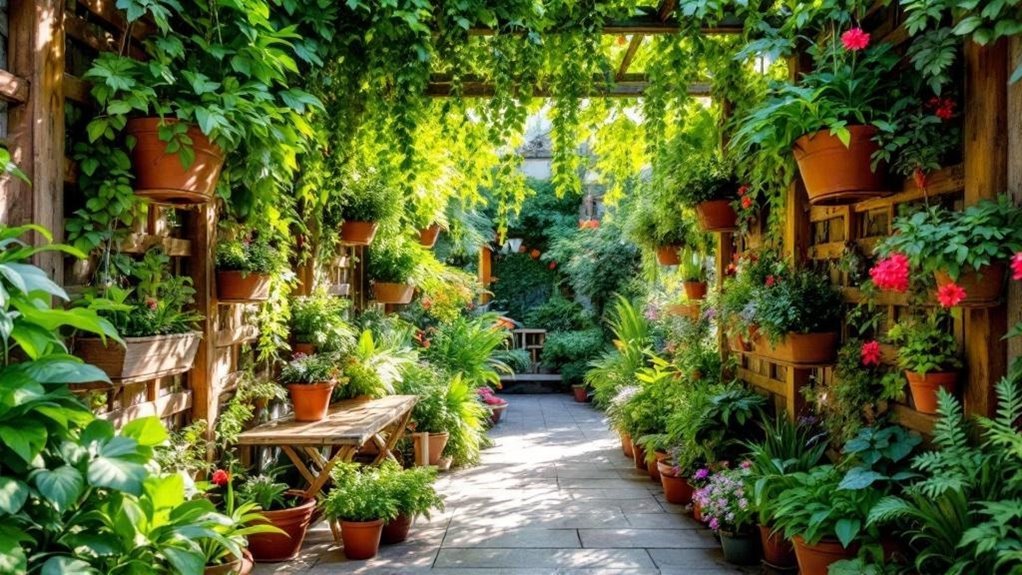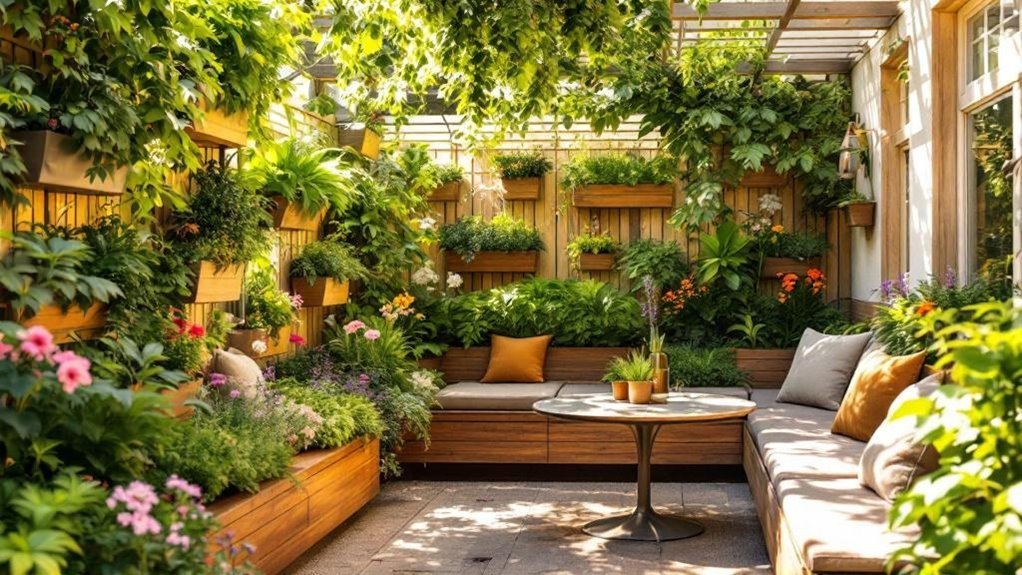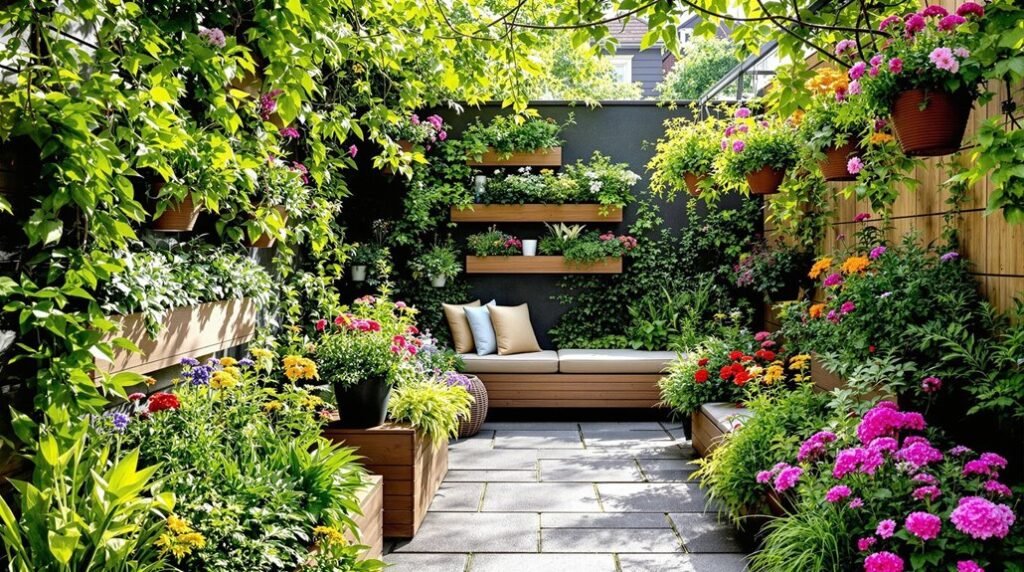Think of your small garden as a blank canvas where every brushstroke counts. You’ll want to carefully assess your space, considering light, layout, and potential vertical options. Choosing the right plants and containers can transform tight quarters into a lush retreat. But how do you balance functionality and beauty without overcrowding? Let’s explore practical steps to make your garden feel larger and more inviting.
Assessing Your Available Space
Before you start planting, measure your garden space carefully and note any existing features like trees, structures, or pathways that might limit your options.
In a small garden, every inch counts, so you’ll want to create a plan that matches what your plants need to thrive. Assess the soil quality and sunlight exposure to pick the best spots for your plants.
Don’t forget to maximize space by using vertical space—walls, fences, and trellises are perfect for this. Container gardening is another great way to expand your options, especially if your soil is poor or crowded.
Look for underused spots, like narrow paths or rocky areas, and turn them into productive spaces. This thoughtful assessment sets the foundation for a flourishing small garden.
Choosing the Right Plants for Small Gardens
When you choose plants for a small garden, selecting compact or dwarf varieties helps prevent overcrowding and keeps your space visually balanced.
Choosing the right plants for small spaces means focusing on multi-functional plants that offer beauty and utility, like flowering fruit bushes or herbs.
While vertical gardening is a powerful strategy, here you’ll prioritize ground-level selections that add visual interest without overwhelming your garden.
Grouping plants thoughtfully enhances the charm and cohesion of your garden.
- Embrace compact plant varieties to save space and maintain order
- Select climbing plants to add layers without using ground area
- Use multi-functional plants to maximize both form and function
- Cluster plants in groups of three for natural, eye-catching appeal
Your small garden will thrive with these smart plant choices.
Utilizing Vertical Gardening Techniques

Although small gardens have limited floor space, you can dramatically expand your growing area by using vertical gardening techniques. By installing trellises and wall-mounted planters, you allow climbing plants like sweet peas and cucumbers to grow upward, maximizing space and improving air circulation.
Layering plant heights adds depth and visual interest, making your garden feel larger and more inviting. Utilizing a retaining wall for cascading plants brings eye-level blooms that enhance aesthetics without crowding the ground.
Layering plants and using retaining walls create depth and vibrant eye-level blooms without sacrificing ground space.
Incorporate potted plants on multiple levels or hanging baskets to optimize vertical space further. These strategies not only increase your garden’s productivity but also create a dynamic, lush environment that thrives despite limited horizontal room.
Embrace vertical gardening to transform small spaces into vibrant, functional gardens.
Incorporating Containers for Flexibility and Structure
Containers bring unmatched flexibility and structure to small space gardens, letting you rearrange plants easily to suit your style or seasonal changes.
Using containers in your garden design allows you to create focal points by elevating pots and drawing the eye. Grouping containers helps define the space, creating cozy outdoor rooms that feel intentional. They also maximize vertical space, letting you include diverse plants without overcrowding.
Plus, containers solve soil or water issues by isolating plants from poor ground conditions.
- Enjoy the freedom to change your garden’s look anytime
- Highlight your favorite plants with striking focal points
- Create intimate, defined areas that invite relaxation
- Embrace a lush, layered garden without sacrificing space
With containers, your garden stays flexible, structured, and full of life.
Designing Functional and Comfortable Seating Areas

Creating functional and comfortable seating areas transforms your small garden into a welcoming retreat where you can relax and connect with nature. When designing functional seating areas, position benches or chairs against fences to enhance privacy and create a sense of intimacy. Arrange seating in cohesive clusters to define garden spaces and encourage conversation. Choose comfortable seating options with cushions that complement your garden’s colors and materials, ensuring a cohesive look. Consider adding a gazebo or teahouse to create a tranquil nook for reflection.
| Seating Placement | Comfort Features | Design Impact |
|---|---|---|
| Against fences | Cushioned benches | Enhances privacy |
| Clustered arrangements | Ergonomic chairs | Creates intimacy |
| Gazebo or teahouse | Soft fabrics | Defines garden spaces |
| Matching materials | Weather-resistant | Cohesive look |
| Flexible layout | Adjustable cushions | Invites relaxation |
Enhancing Visual Appeal With Color and Texture
When you focus on a limited color palette in your flower beds, you create a harmonious and cohesive look that prevents your small garden from feeling cluttered.
Layering plants with varying heights, colors, and textures adds depth, making your garden feel dynamic and inviting.
Combine different plant heights, colors, and textures to bring depth and liveliness to your garden space.
Vertical gardening lets you maximize visual appeal by drawing the eye upward without crowding your small space.
Mixing coarse and fine textures, like hostas with ferns, creates a rich tapestry that delights the senses.
Bright containers also add pops of color and structure, letting you rearrange as your garden evolves.
- Experience the calm of a unified color scheme
- Delight in the contrast of diverse textures
- Enjoy the vertical dimension that saves space
- Feel the freedom to update your garden’s look
Maintaining Plant Health and Soil Quality
To maintain plant health, regularly amend soil with compost or organic fertilizers every 3-4 weeks to supply vital nutrients and boost soil quality. Pay attention to spacing by leaving at least 3/4 of suggested distance between plants, allowing roots room to grow without nutrient competition.
Monitor moisture levels closely—using containers under trees can reduce root competition and help potted plants thrive. Add crushed eggshells as a natural calcium source to improve soil structure and prevent issues like blossom end rot. Additionally, consider using organic fertilizers that promote gradual nutrient release and enhance soil health.
Stick to a balanced feeding schedule and avoid over-fertilization to protect soil pH and promote strong, healthy growth in your compact garden space.
Frequently Asked Questions
What Is the 70/30 Rule in Gardening?
The 70/30 rule means you dedicate 70% of your garden to visually appealing plants and 30% to functional elements like paths or seating. It helps you balance beauty and practicality in your garden space.
How to Maximize Space in a Small Garden?
Like stacking books on a shelf, you’ll maximize your small garden by using vertical containers and trellises. Arrange plants in triangles, amend soil regularly, and create cozy outdoor rooms with seating to fully enjoy your space.
What Is the Rule of 3 in Gardening?
The Rule of 3 means you group plants or features in threes to create balance and visual interest. You’ll mix heights, colors, and textures to make your garden more inviting and lively.
What Is the Gardening 3 Year Rule?
The Gardening 3 Year Rule means you should give plants at least three years to establish strong roots and mature before deciding to remove or replace them. Patience helps your garden thrive and look its best over time.
Final Thoughts
Designing your small space garden is like composing a melody—each element plays an essential part in creating harmony. By carefully evaluating your area, choosing the right plants, and using vertical gardening and containers, you’ll make the most of every inch. Add cozy seating and mix colors and textures to keep it lively. With regular care, your garden will thrive, turning your small space into a vibrant, inviting oasis you’ll love spending time in.
